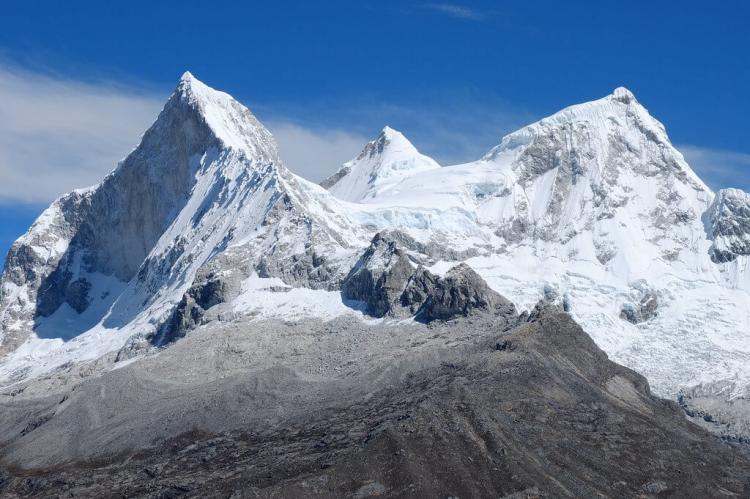Exploring the Majestic Cordillera Blanca: Peru's Alpine Wonderland
Peru's Cordillera Blanca showcases the Peruvian Andes' breathtaking beauty and ecological richness. Nestled in the north-central part of the Cordillera Occidental, it is renowned as the world's highest tropical mountain range, boasting towering peaks, sprawling glaciers, and pristine lakes.
Exploring the Majestic Cordillera Blanca: Peru's Alpine Wonderland
Peru's Cordillera Blanca is a testament to the breathtaking beauty and ecological richness that grace the Andes mountain system. Nestled in the north-central part of the Cordillera Occidental, this remarkable range is renowned as the world's highest tropical mountain range. It boasts towering peaks, sprawling glaciers, and pristine lakes that captivate the imagination of all who behold them.
Geographical Overview
Stretching over approximately 180 kilometers (110 miles) with a southeast-to-northwest trend, the Cordillera Blanca commands attention with its snow-capped summits and rugged terrain. Situated in the Ancash region of Peru, it runs parallel to the Santa River valley, creating a stunning juxtaposition of lush valleys and imposing peaks. The range's eastern flank serves as a continental divide, with the Santa River draining into the Pacific Ocean and the Marañón River flowing into the Atlantic Ocean.
Huascarán National Park is the custodian of this majestic landscape, encompassing nearly the entire Cordillera Blanca. Recognized by UNESCO as a Biosphere Reserve and World Heritage Site, the park safeguards the range's ecological integrity, ensuring its preservation for future generations.
Glacial Splendor and Hydrological Significance
At the heart of the Cordillera Blanca lies its crowning glory: a network of glaciers epitomizing the region's natural grandeur. Boasting the world's most extensive tropical ice-covered mountain range, the Cordillera Blanca is a vital source of freshwater for northern Peru, sustaining local communities and ecosystems. The melting snow and ice feed into the Santa River, which provides a year-round water supply and supports hydroelectric power generation, contributing to Peru's energy needs.
Despite their resilience, the glaciers of the Cordillera Blanca have not been immune to the impacts of climate change. Over the past century, these icy giants have experienced significant retreat, with studies indicating a reduction of over 15% since the 1970s. Satellite imagery reveals the stark reality: a landscape in flux, where glaciers recede and landscapes transform.
A Tapestry of Lakes and Hot Springs
Dotting the Cordillera Blanca are numerous glacial lakes, each reflecting the range's glacial heritage and geological diversity. From the tranquil turquoise waters of the Llanganuco Lakes to the expansive expanse of Lake Parón, these natural wonders offer a glimpse into the range's pristine beauty. Adventurers can embark on treks to discover hidden gems like Lakes Ichiccocha and Jatuncocha, nestled amidst the peaks of Artesonraju and Alpamayo, or soak in the rejuvenating waters of hot springs like Monterrey and Chancos, transformed into thermal bath facilities for visitors' relaxation and enjoyment.
Flora and Fauna
The Cordillera Blanca is a sanctuary for adventurers and a haven for diverse flora and fauna that call these rugged landscapes home. From the arid valleys to the high-altitude grasslands, a tapestry of plant communities thrives, showcasing adaptations to the region's harsh climate and extreme conditions. Puna grasslands, high Andean forests, and xerophytic plants paint a vibrant picture of resilience and adaptation to adversity.
Amidst this botanical wonderland, a plethora of bird species grace the skies of Huascarán National Park, from the majestic Andean condor to the elusive puna tinamou. Meanwhile, the range's rugged slopes are inhabited by many mammals, including the elusive Andean mountain cat, the iconic spectacled bear, and the graceful vicuña, each contributing to the rich tapestry of biodiversity that defines the Cordillera Blanca.
Preserving a Natural Heritage
As stewards of this precious ecosystem, efforts to conserve and protect the Cordillera Blanca are paramount. Through initiatives aimed at sustainable tourism, habitat restoration, and community engagement, Peru strives to ensure the long-term viability of this natural treasure, safeguarding its ecological integrity for generations to come.
In conclusion, the Cordillera Blanca is a testament to Peru's natural landscapes' awe-inspiring beauty and the ecological significance of Peru's natural landscapes. From its towering peaks to its pristine lakes and vibrant ecosystems, this majestic mountain range captivates the hearts and minds of adventurers and conservationists alike, offering a glimpse into the unparalleled wonders of the Andes.

Map of Peru and its cordilleras: the Cordillera Blanca is located in the north-central part of the Cordillera Occidental.





